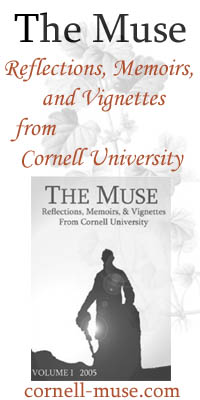Readers may have noted that a draft copy of a book was linked on MetaEzra this past week. It appears that the University is planning on publishing a copy of former-President Lehman's speeches this fall, complete with a forward by President Skorton, and additional commentary by Lehman that will provide needed insight into the Lehman Presidency. This is exciting. With no disrespect to the leadership that President Skorton has provided to Cornell, who can resist Lehman's address to incoming freshmen on the underlying meaning to an oft-quoted line from The Big Lebowski when compared to more boilerplate fare? All Cornellians, past and present, should read Lehman's speeches, including his Commencement address on Vonnegut and Satre and his inaugural address as the first Cornell alum ever to assume the institution's presidency -- when he introduced the powerful theme of a Revolutionary and Beloved Cornell. This is also exciting because the publication of the book indicates an interest in the University to integrate the Lehman years into Cornellian's collective conscious, to perhaps help heal the wounds that opened in 2005 with Lehman's sudden and surprising resignation. So we're glad that all parties are being gracious towards each other, even as we wish that the Board of Trustees would have been more forthcoming all along in regards to the source of their tension with Lehman. Of course, Lehman is busy pursuing other endeavors besides for compiling a book of his speeches. Not only has he taken the lead in bringing an American law school to the Far East, but he has also recently written on how to measure the amount of integration that occurs within diverse student bodies. Student diversity, integration, and self-segregation has always been a hot topic for MetaEzra, so we took some interest to this article. Lehman writes: More precisely, one needs to be looking at flows, not snapshots. An evaluation should be structured to monitor the movements within with an individual’s daily life. It should be longitudinal rather than cross-sectional... Consider once more the context of racial integration. Suppose one were to take a series of snapshots of a role reversal integration pod. Suppose that in every snapshot one found 8 black students and 2 white students. And, upon closer inspection, suppose one found that one of the 2 white students was always the same. It might be tempting to focus on the student who was always there and say, “This integration pod isn’t having much of an impact; the same white student is here all the time.” But if the point is to evaluate the prevalence of a role reversal experience within the community over time, the lesson of the poverty spells example is that one must not look at individual snapshots. One must look at the entire population over time. The question is not “there now,” but rather “ever there.” There is a common point to both the cafeteria example and the role reversal example. The point is that, to evaluate how one is doing, one must resist the psychological temptation to fixate on indicators of failure. One must not fixate on homogeneous lunchroom tables or on the white student who seems to be in the role reversal pod every day. Rather, one must try to see the entire picture, over time.One should not feel any particular sense of alarm if, when one looks at into a lunchroom, one sees a table at which all of the students are black. What one needs to look for are integration pods – venues where mixed-race groups are interacting. Even a relatively small number of such venues might be enough to sustain a meaningfully integrated community.
In Lehman's mind, these integration and role-reversal pods work against the inherent trends towards self-segregation that occur everywhere in life. And I think most would agree with his assessment of the types of integrative institutions that can enrich a student's educational experience.
Integration among a diverse student body is important due to it's ability to build trust and community on campus. Harvard's famed Robert Putnam has been writing a lot about this recently, claiming that more diversity is associated with all sorts of negative outcomes, including less likelihood of giving to charity or volunteering, fewer close friends and confidants, and less happiness and a lower perceived quality of life.
I will suggest that this is more of a problem at Cornell than at most other universities. Not only do you have a lot of racial, ethnic, culturally, and socioeconomic diversity, but you also have more academic and residential diversity than at most other top private universities. Any person. Any study.
So it's curious that Lehman doesn't talk about the Cornell experience more fully. He only adds one anecdote from his time at Cornell:
As president of Cornell, I was struck by the extraordinary alliance between Muslim students and Jewish students on campus. Year in and year out, I saw remarkable efforts at joint programming, so that students from each group might come to appreciate the perspectives of the other. One year the students collaborated to design and make a mosaic. In other years the end of Ramaddan featured an Iftar banquet that drew hundreds and hundreds of students into a comparative discussion of the role of fasting in different religions. In still another year Iranian Muslim students and Sephardi Jewish students staged a joint evening of culture, food, and comedy.
But I think there is a lot more to talk about:
Would a more integrated university allow freshmen to self-segregate themselves before they even arrive on campus? Would a more integrated university allow camaraderie building athletic traditions at Lynah to be squashed? Would a more integrated university seek to include all alums in the distribution of its alumni magazine?


